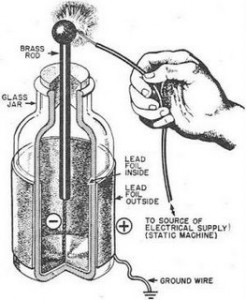Not usually needed or practical unless you need some extremes: a couple pF as in fine tuning some RF stage or as shown above, hairy multi kV ones.
The very first capacitor was the Leyden Jar, a glass jug with inside and outside covered in thin metal leaf.
Ben Franklin DIYed his own, go figure:

The very first capacitor was the Leyden Jar, a glass jug with inside and outside covered in thin metal leaf.
Ben Franklin DIYed his own, go figure:

This is totally kitchen science.
https://www.onelectrontech.com/lab-diy-capacitors/
https://rimstar.org/science_electronics_projects/make_electrolytic_capacitor.htm
https://www.onelectrontech.com/lab-diy-capacitors/
https://rimstar.org/science_electronics_projects/make_electrolytic_capacitor.htm
Cheap TV's in the fifties had caps made of wound aluminum foil and paper, all insulated in cellophane wrap. They looked like a piece of candy. Winding looked ragged. Weren't even round. Montgomery Ward Airline, Western Auto, the like. Bad sensitivity, fuzzy pictures, bad contrast, ghosts. Not all the faults were the caps of course, lots of other cost cutting measures that didn't look as bad. Resistors weren't AllenBradley. The Philco TV Mother bought in 1954, that lasted until 1978 when the wife gave it away, had cylindrical paper caps with waxed ends; much better looking. Much better picture, too.
For fun and games, maybe but not for hi-fi.
It takes big expensive machines to make good film capacitors.
It takes big expensive machines to make good film capacitors.